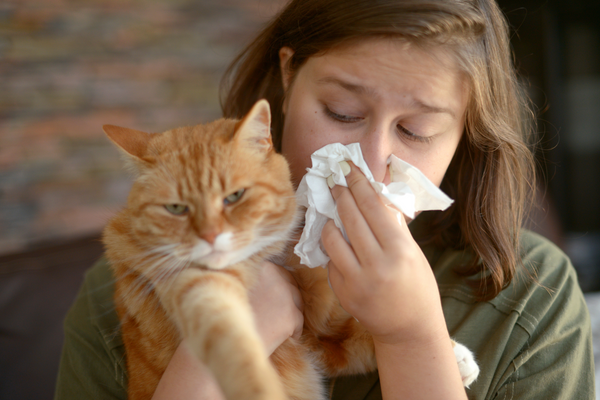Why Cat Urine Smells So Terrible–And What You Can Do About it

As a cat parent, is there anything more panic-inducing than getting hit with a whiff of cat pee stench anywhere other than inside of the litter box? Of course, accidents are bound to happen. However, if your nose has ever been plagued by the terrible, awful, bad smell of cat pee–you know how distinctly offensive it is–and how hard it is to get rid of. But why, exactly, does cat urine smell so terrible? Why does it smell so much worse than dog pee? And what’s the best way to clean it up? In this article, we’ll weigh in on this pungent mystery and give you the best tips on eliminating this particular odor, for good.
Why Exactly Does Cat Pee Smell So Terrible?
Not only do cats have nine lives, but our feline friends are also well-adapted to survive in various “hairy” situations. For instance, one of their hidden talents is their ability to use water remarkably efficiently. Since they originated in the desert, cats’ bodies evolved to absorb a large amount of water from their urine to maintain hydration, which means they don’t need to drink as much water as other animals. This also means that cats have super-concentrated urine–darker than most animals–and certainly more foul-smelling. Cats have much stronger concentrated urine than dogs. Dog pee is much more diluted, meaning it is less pungent and less yellow in color than cat pee. The good news for cat parents? Cats urinate less frequently than dogs.
There are other contributing factors to cat pee’s terrible, awful scent. Urine from male cats tends to smell worse than female urine because of hormones and pheromones, which can make non-neutered male cat pee stink for days. Older cats, cats with compromised kidneys, and cats with urinary tract issues will also have extra foul-smelling urine.
What gives cat urine such a bad name (and smell) is the fact that the urine is usually left unnoticed until it becomes a problem. Some cats tend to mark their territory outside of the litter box, be it in hidden corners, on the carpet, or under the bed. After a while, bacteria decompose the urea and give off the distinct ammoniacal stench characteristic of stale, old cat pee.
Consider Your Cat’s Health & Behavior
If your cat is suddenly having uncharacteristic accidents around your home, it's worth a trip to the vet to get things checked out. If your veterinarian finds that your cat is healthy, but accidents are still happening, you may need to address the litter box situation. It’s possible that your cat could have developed an aversion to the litter box itself, the condition or type of litter, or the location of the box. Depending on how much your cat wants to avoid the litter box, they may continue to use it inconsistently. And, unfortunately, a cat with an aversion to a litter box will usually eliminate on various surfaces. As a result, you may find feline feces or puddles of cat pee on soft surfaces like beds, carpets, clothing (full laundry baskets are the favorite litter box substitute of many felines), or on hard surfaces like tile floors or inside the bathtub.
Things to Avoid When Cleaning Up Cat Accidents
Many products out there claim to remove odors and stains from pet accidents, but it’s essential to avoid using products that contain certain ingredients. First, it’s crucial to avoid using products containing ammonia to clean up cat urine. Cats are likely to mistake the ammonia scent for urine and will likely repeatedly pee in the same place to mark their territory.
Another common mistake cat owners make is using bleach to clean up cat urine. This is a hazardous combination that can result in dangerous gasses. Never use bleach to clean items soiled with urine.
And while home remedies and heavily fragranced cleaning products may momentarily mask the pungent stench of cat pee, the smell will inevitably come back to invade your nostrils.
When dealing with cat pee, the odor must be neutralized. Otherwise, the stench will continue to well, stink, and your cat will likely continue to pee on surfaces they’ve already marked with their scent. Keep in mind that cat pee is loaded with uric acid. Therefore, the longer cat urine saturates a surface, the tighter it bonds to it. And if you live in a humid climate? The odor will be even more difficult to eliminate because once the uric acid comes into contact with the moisture in the air, the uric acid crystals left behind can reform and re-release the stench again. Yikes!
For best cat-pee-odor-busting success, it’s essential to clean soiled items and surfaces quickly and effectively. Remember, cleaning is most effective when it is done immediately after an accident, and odors must be neutralized, not just covered up.
The bottom line: To clean up cat pee and eliminate the smell, using an odor neutralizer is a must.
Vital Oxide is a Must-Have for Cat Parents
Whether it’s cat pee, feces, vomit, or hairballs, Vital Oxide has the cleaning power to neutralize foul-smelling odors and stubborn stains, for good. Rather than masking odors with fragrance, Vital Oxide harnesses the cleaning power of oxygen–in the form of stabilized chlorine dioxide–to destroy tough odors. Vital Oxide contains no harsh chemicals, noxious fumes, harmful residues, or alarming safety warnings. It is gentle enough to use around pets and is ideal for use on carpets, upholstery, floors, furniture, fabrics, litter boxes, and more. After use, Vital Oxide breaks down to a simple salt and produces no harmful by-products.
Here’s how to use Vital Oxide to clean and neutralize tough feline messes:
How To Remove Cat Pee From Carpets or Upholstery
Start by using paper towels to blot up as much of the pee as possible, being careful not to rub it in. Next, rinse the area with a bit of warm water mixed with a small amount of baking soda to dilute the remaining urine and neutralize the uric acid. Repeat the first step to blot up as much of the urine and water as possible.
Finally, spray Vital Oxide (full-strength) on the area to eliminate odors and stains. Be sure to use enough of the formula to penetrate the carpet or upholstery fibers and all places the urine may have saturated. Allow Vital Oxide to dwell on the soiled carpet for at least 10 minutes. There is no need to rinse; simply let air dry. A fan can be used to dry the carpet or upholstery faster if needed. Repeat as needed for extra pungent stains.
Cleaning Heavily Soiled Carpets & Upholstery
Vital Oxide can be added to the tank of a carpet cleaner or hot water extractor for heavily soiled carpets and upholstery. Vital Oxide is safe for use on stain-protected carpet and fabric finishes and can be used as a carpet pre-spray or in the tank of hot water extraction units to neutralize tough odors and sanitize carpets. When using a carpet cleaner or hot water extractor, follow the manufacturer’s instructions on cleaning for best results. For odor removal, Vital Oxide must be used full-strength. Allow Vital Oxide to dwell on the soiled carpet for 10 minutes. Then, do not rinse. Instead, use an extraction wand and dry stroke carpet to remove excess moisture. After cleaning, allow the carpet to air dry for at least eight hours (ideally overnight) or use circulation fans to speed up the drying process.
NOTE: Before using any cleaning product on carpet, always test it on the fibers in an inconspicuous spot to ensure it does not cause discoloration. Spray the solution on the fibers. Let it sit for five minutes and then blot with a clean white cloth. If there is color transfer, do not use the product on your carpet.
How To Clean Cat Excrement & Stains
Start by picking up the droppings if they are solid. If the mess is wet, like diarrhea or vomit, try to get as much of it as you can, working as fast as possible to avoid letting the stain set. A good trick is to put on rubber gloves and use a dustpan to scrape up most of the mess and then paper towels to remove the rest of it. Be careful not to force the mess into the carpet or upholstery as you’re cleaning! After you’ve picked up the mess, saturate the area with Vital Oxide and let it work its magic.
How To Find Hidden Cat Pee in Your Home
As mentioned above, cat pee sprayed but gone unnoticed is what gives cat pee its reputation for smelling particularly offensive. If you get a whiff of cat urine but can’t quite pinpoint its location, try using a black light to detect it (it will glow under the ultraviolet light) and then treat with Vital Oxide to bust the odor-causing bacteria.
How To Use Vital Oxide To Clean Your Cat’s Litter Box
All cat parents know the struggle of keeping litter boxes smelling fresh. And while high-quality kitty litter is a must, it’s simply not enough to prevent odors. Instead of scooping only when you see big clumps, try scooping litter twice daily and replace the litter entirely once a week. After emptying the litter box, scrub it with fragrance-free dish soap and hot water. Rinse, and then spray the litter box with Vital Oxide to disinfect and neutralize odor-causing bacteria. Let the litter box air dry before refilling with fresh litter. This routine will keep your kitty’s litter box smelling purr-fectly fresh.
Have questions about cleaning up pet accidents or reducing harsh chemicals in your home? We have answers! The Ecology Works has been leading the way in green cleaning since 1993. Please feel free to Contact Us or message us on Facebook. No question is too small! We're here to help.





